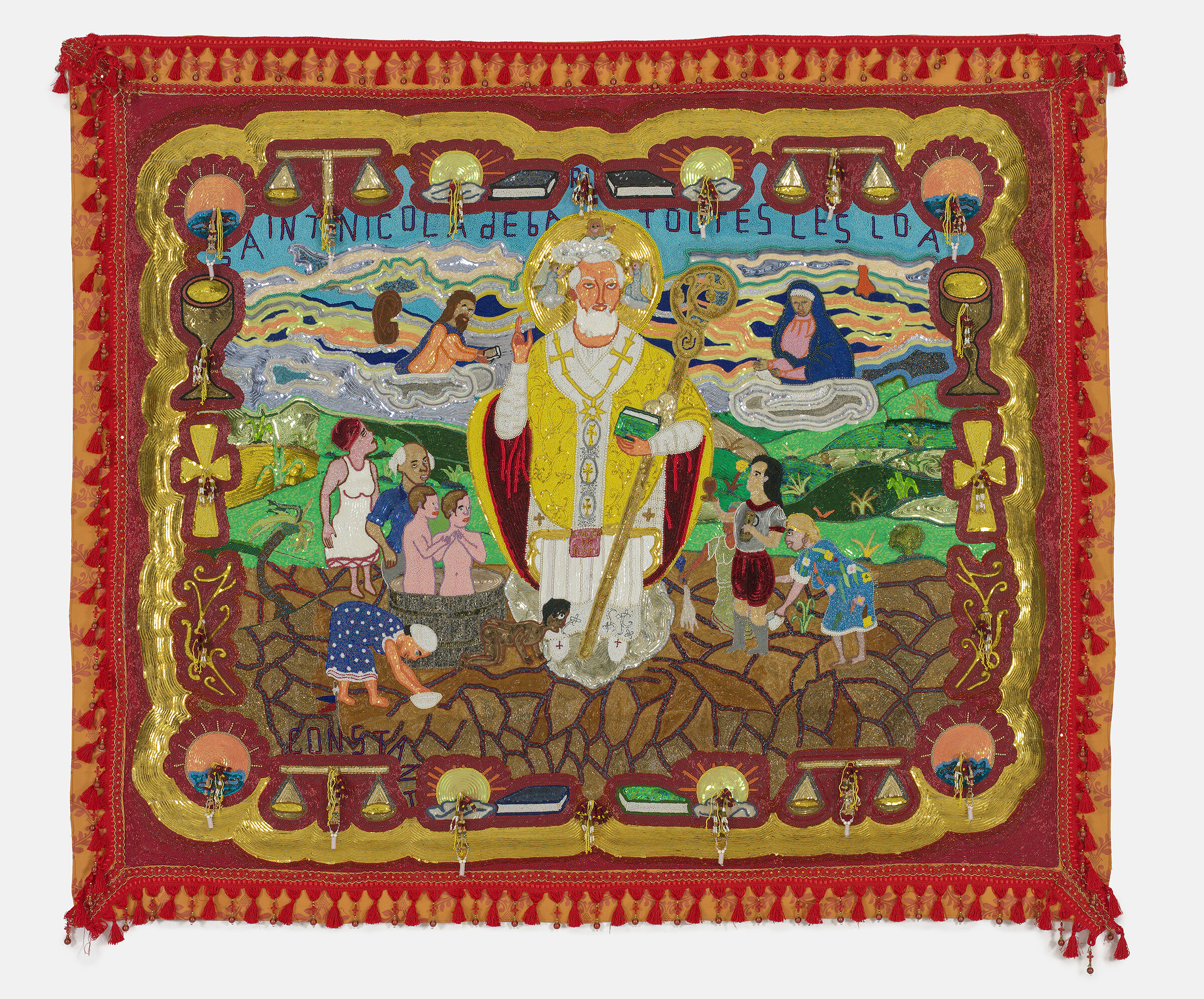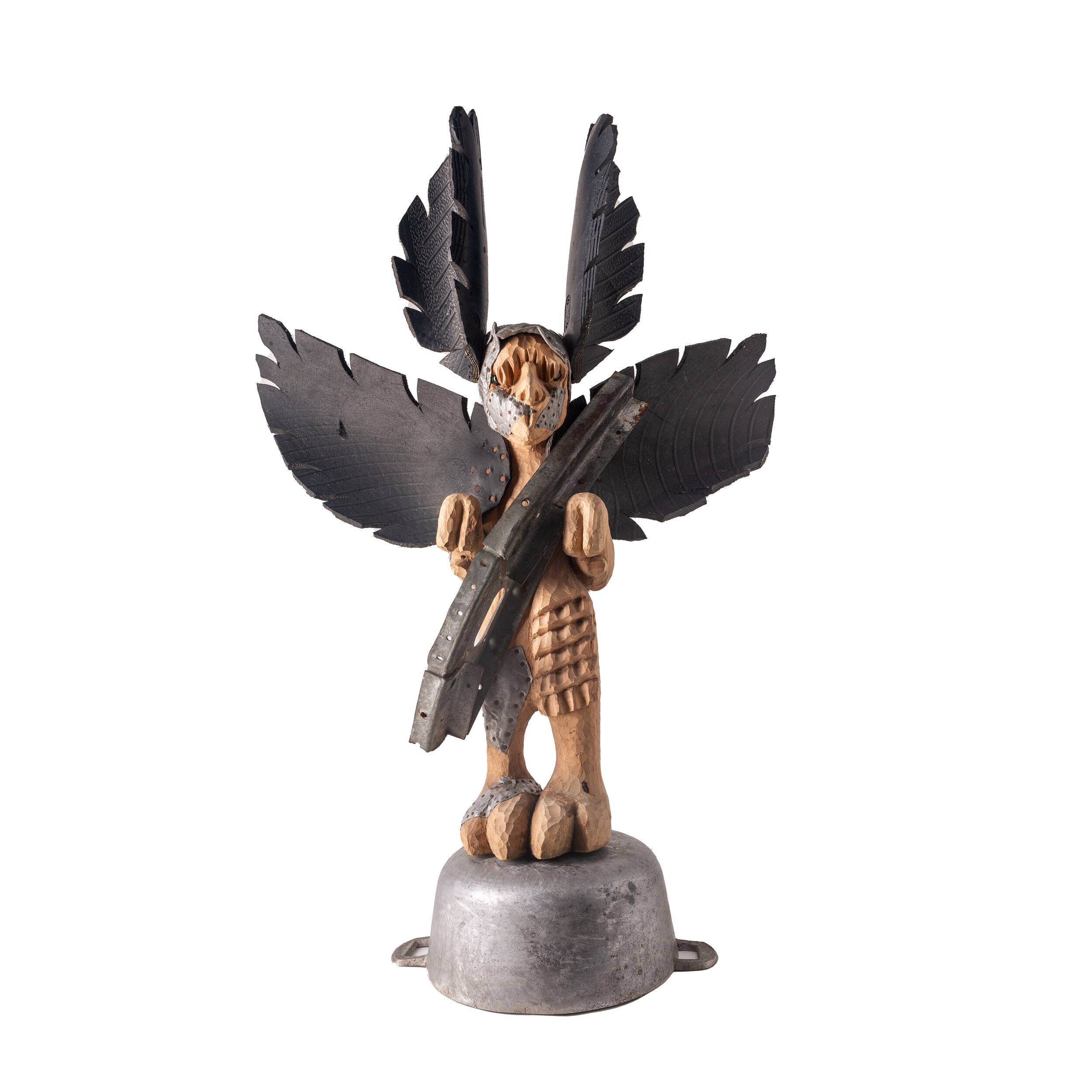





























Your Custom Text Here
December 2, 2020–January 20, 2021
The gallery will be open by appointment only, please make one at central@centralfine.com
In this presentation curated by Tomm El-Saieh, new and historical works are brought together to offer three important artistic perspectives in Haitian Art.
André Pierre’s paintings of the Loa (spirits of Haitian Voodoo, often referred to as “the Mysteries” or “the Invisible Ones”) have influenced many artists in Haiti, including Myrlande Constant and Jean-Hérard Celeur. Echoes of Pierre’s paintings are present in Constant and Celeur’s current work. In this presentation, mermaids abound, humanoid birds stand erect, and “the Invisible Ones” (the Loa) congregate in same space.
André Pierre
Pierre, a Voodoo Priest, painted on gourds destined for offerings to the Voodoo deities until his friend, Maya Deren, introduced him to Le Centre D’Art in Port-au-Prince during the late 40s and suggested that he started painting on wooden panels and canvas. This transition introduced Pierre’s work (which had previously only been seen by Voodoo practitioners attending ceremonial spaces) to a wider audience. In December 2016, Tomm El-Saieh curated André Pierre’s first solo presentation at CENTRAL FINE; many of the exhibited works were then loaned for documenta 14 (2017) in Athens and Kassel.
Myrlande Constant
In 2018, El-Saieh curated Myrlande Constant’s first solo presentation at the CENTRAL FINE. Constant’s Voodoo flags have revolutionized the process of traditional Voodoo flag-making since the 90s by introducing a series of innovations to these sacred objects. Traditionally, Voodoo flags are built using sequins, shining objects intended to invoke the Loa and thereby call them into religious ceremonies. The flags are filled with imagery of veves (religious Voodoo symbols). Constant introduced tambour beading to her Voodoo flags, an ancient embroidery technique used for haute couture which she learned while working at a wedding dress factory in the 90s. She composes her new works with scenes that present the Loa and humans in connection—in exchanges, engaging in various activities. In her works, the Guede (deities that embody Fertility and Death) are sometimes seen drinking and playing music, while humans start changing, as if taken by the spirits.
Constant’s works, densely constructed in glass beads and sequins, also bring the mundane and the divine together. An electric guitar frames a scene where sirens and water deities are reunited. The golden electric guitar is sewn next to albino fish (offerings to the deities). The deliberate placement and merging of highly diverse elements within the same composition reveals an essential element of Constant’s work. Her Voodoo flags create a space that is not affected by the laws of a conditioned reality, but rather, is guided by other forces—the Artistic and the Religious experience.
Constant embroiders her last name as a ‘constant,’ as a signifier that floats over the scenes on her flags, revealing a notion of self-portraiture in her works as well as suggesting that her representation of Voodoo deities is highly personal. This key aspect links Myrlande Constant’s work to Andre Pierre’s—both artists give faces to the Loa (the Invisible Ones), bringing them into our realm. Constant, however, expands her repertoire of Voodoo representation by creating new faces for the deities, developing a ‘lexicon,’ a highly personalized encyclopedia that represents the invisible forces in Voodoo Religion. She also sometimes uses the fabric that frames her works to make her own dresses, another cross-over between fashion and religion, which ultimately expresses a need to utilize material means in various, unexpected ways. At the Faena Festival: “The Last Supper” (curated by Zoe Lukov, 2019), Constant exhibited one of her largest works to date, which she decided to frame with a black circular garment. She used the remaining material to fashion herself a dress and a head-piece, which she wore at the opening, dressing and enveloping herself with the same framing material of her work.
Jean-Hérard Celeur
Jean-Hérard Celeur’s sculptures present hybrids of humanoid birds in war-like attire. Often made from found wood or car tires, his sculptures reclaim and repurpose discarded materials and the associations they carry, underlining the widespread poverty that surrounds Celeur in Haiti and the ensuing need to use any and all available resources to denounce it. “My work has social and intellectual aspects, and represents the people’s demands for change,” explains Celeur. “I live in the reality that deals with poverty every day.”[i] In his studio, a standing mermaid sporting a wired hat expresses gestures of political and artistic resistance as well as a desire to bring together the divine figure with the poverty and scarcity prevalent in Haiti. Death and life, sex and celebration, violence and excess, politics and sociological concerns, encounter each other in Celeur’s works.
Works by André Pierre (b. 1916, Port-au-Prince, Haiti; d. 2005) have been presented in numerous international exhibitions, most recently at documenta 14 (2017) in Athens and Kassel. Pierre painted at the El-Saieh gallery in Port-au-Prince, Haiti for over 21 years.
Myrlande Constant (b.1968, Port-au-Prince, Haiti) has exhibited her work at Pioneer Works, New York; the Museum of Contemporary Art, North Miami; Le Grand Palais, Paris; Brown University, Providence; among other institutions. Constant has also presented her work at the El-Saieh Gallery, Port-au-Prince, and CENTRAL FINE, Miami Beach, among other locations. A survey of her work, curated by Katherine Smith, will take place at the Fowler Museum, University of California, Los Angeles in 2021.
Jean-Hérard Celeur (b. 1966, Port-au-Prince, Haiti) has exhibited at the 54th Venice Biennale; Le Grand Palais, Paris; Pioneer Works, New York; The Frost Art Museum, Miami; the El-Saieh Gallery, Port-au-Prince; among other venues. Celeur is a senior member of Atis Rezistanz, a group of sculptors working at the Grand Rue in Port-au-Prince.
[i] Gordon, Leah, “The Sculptors of Grand Rue: Reinterpreting Slavery,” Dazed & Confused (March 2007).
December 2, 2020–January 20, 2021
The gallery will be open by appointment only, please make one at central@centralfine.com
In this presentation curated by Tomm El-Saieh, new and historical works are brought together to offer three important artistic perspectives in Haitian Art.
André Pierre’s paintings of the Loa (spirits of Haitian Voodoo, often referred to as “the Mysteries” or “the Invisible Ones”) have influenced many artists in Haiti, including Myrlande Constant and Jean-Hérard Celeur. Echoes of Pierre’s paintings are present in Constant and Celeur’s current work. In this presentation, mermaids abound, humanoid birds stand erect, and “the Invisible Ones” (the Loa) congregate in same space.
André Pierre
Pierre, a Voodoo Priest, painted on gourds destined for offerings to the Voodoo deities until his friend, Maya Deren, introduced him to Le Centre D’Art in Port-au-Prince during the late 40s and suggested that he started painting on wooden panels and canvas. This transition introduced Pierre’s work (which had previously only been seen by Voodoo practitioners attending ceremonial spaces) to a wider audience. In December 2016, Tomm El-Saieh curated André Pierre’s first solo presentation at CENTRAL FINE; many of the exhibited works were then loaned for documenta 14 (2017) in Athens and Kassel.
Myrlande Constant
In 2018, El-Saieh curated Myrlande Constant’s first solo presentation at the CENTRAL FINE. Constant’s Voodoo flags have revolutionized the process of traditional Voodoo flag-making since the 90s by introducing a series of innovations to these sacred objects. Traditionally, Voodoo flags are built using sequins, shining objects intended to invoke the Loa and thereby call them into religious ceremonies. The flags are filled with imagery of veves (religious Voodoo symbols). Constant introduced tambour beading to her Voodoo flags, an ancient embroidery technique used for haute couture which she learned while working at a wedding dress factory in the 90s. She composes her new works with scenes that present the Loa and humans in connection—in exchanges, engaging in various activities. In her works, the Guede (deities that embody Fertility and Death) are sometimes seen drinking and playing music, while humans start changing, as if taken by the spirits.
Constant’s works, densely constructed in glass beads and sequins, also bring the mundane and the divine together. An electric guitar frames a scene where sirens and water deities are reunited. The golden electric guitar is sewn next to albino fish (offerings to the deities). The deliberate placement and merging of highly diverse elements within the same composition reveals an essential element of Constant’s work. Her Voodoo flags create a space that is not affected by the laws of a conditioned reality, but rather, is guided by other forces—the Artistic and the Religious experience.
Constant embroiders her last name as a ‘constant,’ as a signifier that floats over the scenes on her flags, revealing a notion of self-portraiture in her works as well as suggesting that her representation of Voodoo deities is highly personal. This key aspect links Myrlande Constant’s work to Andre Pierre’s—both artists give faces to the Loa (the Invisible Ones), bringing them into our realm. Constant, however, expands her repertoire of Voodoo representation by creating new faces for the deities, developing a ‘lexicon,’ a highly personalized encyclopedia that represents the invisible forces in Voodoo Religion. She also sometimes uses the fabric that frames her works to make her own dresses, another cross-over between fashion and religion, which ultimately expresses a need to utilize material means in various, unexpected ways. At the Faena Festival: “The Last Supper” (curated by Zoe Lukov, 2019), Constant exhibited one of her largest works to date, which she decided to frame with a black circular garment. She used the remaining material to fashion herself a dress and a head-piece, which she wore at the opening, dressing and enveloping herself with the same framing material of her work.
Jean-Hérard Celeur
Jean-Hérard Celeur’s sculptures present hybrids of humanoid birds in war-like attire. Often made from found wood or car tires, his sculptures reclaim and repurpose discarded materials and the associations they carry, underlining the widespread poverty that surrounds Celeur in Haiti and the ensuing need to use any and all available resources to denounce it. “My work has social and intellectual aspects, and represents the people’s demands for change,” explains Celeur. “I live in the reality that deals with poverty every day.”[i] In his studio, a standing mermaid sporting a wired hat expresses gestures of political and artistic resistance as well as a desire to bring together the divine figure with the poverty and scarcity prevalent in Haiti. Death and life, sex and celebration, violence and excess, politics and sociological concerns, encounter each other in Celeur’s works.
Works by André Pierre (b. 1916, Port-au-Prince, Haiti; d. 2005) have been presented in numerous international exhibitions, most recently at documenta 14 (2017) in Athens and Kassel. Pierre painted at the El-Saieh gallery in Port-au-Prince, Haiti for over 21 years.
Myrlande Constant (b.1968, Port-au-Prince, Haiti) has exhibited her work at Pioneer Works, New York; the Museum of Contemporary Art, North Miami; Le Grand Palais, Paris; Brown University, Providence; among other institutions. Constant has also presented her work at the El-Saieh Gallery, Port-au-Prince, and CENTRAL FINE, Miami Beach, among other locations. A survey of her work, curated by Katherine Smith, will take place at the Fowler Museum, University of California, Los Angeles in 2021.
Jean-Hérard Celeur (b. 1966, Port-au-Prince, Haiti) has exhibited at the 54th Venice Biennale; Le Grand Palais, Paris; Pioneer Works, New York; The Frost Art Museum, Miami; the El-Saieh Gallery, Port-au-Prince; among other venues. Celeur is a senior member of Atis Rezistanz, a group of sculptors working at the Grand Rue in Port-au-Prince.
[i] Gordon, Leah, “The Sculptors of Grand Rue: Reinterpreting Slavery,” Dazed & Confused (March 2007).